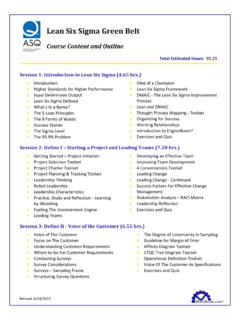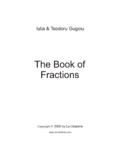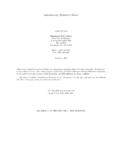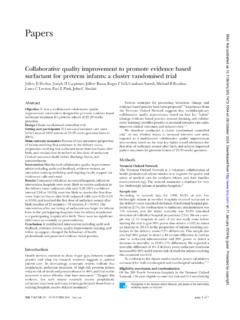Transcription of TEST POWER IN COMPARISON DIFFERENCE …
1 Quantitative Methods Inquires 331 TEST POWER IN COMPARISON DIFFERENCE between TWO independent proportions Mehmet MENDES1 PhD, Associate Professor, Canakkale Onsekiz Mart University, Agriculture Faculty, Animal Science Department, Biometry and Genetics Unit 17020, Canakkale, Turkey E-mail: Erkut AKKARTAL2 PhD, Assistant Professor, Naval Academy, Social Science Department, 34034 Tuzla, Istanbul,Turkey E-mail: Abstract: In this study, the effect of population proportion DIFFERENCE (effect size) and the relation between sample sizes on test POWER in comparing two independent proportions were investigated. At the end of 50 000 simulation experiments it was observed that increasing in the sample size and population proportion DIFFERENCE increase the test POWER while the controversy decreases it.
2 In the case of studies with equal sample sizes, sufficient test POWER level ( %) was obtained by 60, 90, 150 and 350 observations when = , , and , respectively. On the other hand, it is not available to obtain sufficient POWER level even for the extremely large sample size taken into consideration (500 observations) when = Results of this study showed that the inequality in sample size or relations between sample sizes (n2= or n1= ) affect the test POWER . However, total number of observations may be more effective on the test POWER rather than inequality in sample sizes. Key words: Test POWER ; sample size; simulation; comparing two proportions 1.
3 Introduction The statistical method used in evaluating the observed values concluded from an experiment or research changes depending on the way of collecting the data, sample size, the shape of the distribution, the number of factors to be studied, the correlations between the variables, and whether the variances are homogenous or not (Ott, 1998; Mende , 2002). In practice, researchers mostly interested in with the DIFFERENCE of the proportions of observing a property taken from a population which has a binomial distribution ( has only types of two outcomes). That means, we are interested in testing the control hypothesis: 2p1p:0H= against the alternative hypothesis stated as: 2p1p:1H.
4 In testing the Quantitative Methods Inquires 332 hypothesis given above, as known, Z-test is used given as d 2P1PZ = (Winer et al., 1991; Zar, 1999; Sheskin, 2000). If Ho is rejected () , the DIFFERENCE between two proportions is statistically significant. But especially lately, it is emphasized that only rejecting Ho hypothesis itself does not give enough information and there is a great deal of advantage to emphasize how a right decision is made by rejecting it. In other words, embodying the test POWER to the research has a great deal of importance of defining the probability of failure out coming from rejecting the Ho hypothesis.
5 Test POWER can be defined as, the probability of false rejecting of the null (Ho) hypothesis, and expressed as 1- (Adcock, 1997; Mende , 2004a). The lower bound value of the test POWER is accepted as 80% in general (Cohen, 1988; Hoening ve Heisey, 2001; Wilcox, 2002; Mende , 2002; Ferron ve Sentovich, 2002). Calculating the test POWER enables the researcher, not only to get information about the hypothesis which should be rejected indeed but which concurrently will be rejected as a result of the analysis with how much probability, but also to determine an appropriate sample size (Lenth, 2001). As it is known, one of the topics that a researcher should have a difficulty on is to make a decision on the sample size used in the study (Adcock, 1997; Mende , 2005a).
6 Determining the appropriate sample size for an experiment or a research is a crucial component of the study design. Studying with appropriate sample size provides of the researcher to obtain reliable information about the study. However, it is not easy to determine adequate or optimum sample size. Since test POWER and sample size are related to each other, the calculation of test POWER gives at least an idea about whether the sample size of the experiment is enough or not. As a result of this procedure, the researcher may have an idea about the sample size which will be dealt with for the successive experiments. The smallest sample size when an enough test POWER value (80%) obtained, can be accepted as an appropriate or optimum sample size (Ferron and Sentovich, 2002; Mende , 2004b).
7 The major purpose of this study is to determine test POWER and appropriate sample size depending on the experimental conditions such as sample sizes and the population proportion DIFFERENCE or effect sizes. 2. Material and Method The material of this study is composed of the random numbers which are generated from the IMSL library of Microsoft FORTRAN Developer studios (Anonymous, 1994). With this motivation, by the aim of RNBIN sub-function, different sizes of samples are taken from two binomially distributed populations. Random number are chosen for the probability of the selected property to be p1= for the first sample, and p2= , , , and.
8 For the second sample respectively. Subsequently, aimed to estimate the test POWER , the DIFFERENCE between two population proportion is taken as ( =p1-p2), so five DIFFERENCE -of- proportions (effect size) are formed as =p1-p2= , , , and By this motivation, it is observed that how the POWER of the test changes, depending on the DIFFERENCE between two proportions ,. In the study, in order to determine how the differences of the two samples affect the POWER of the test, both the equal sample size (n1=n2) and the unequal sample size (n2/n1= , n2/n1= ve n2/n1= ) cases were taken into consideration. Each experimental condition which has been taken into consideration is Quantitative Methods Inquires 333 repeated for 50,000 times (Mende , 2005b).
9 Subsequently, the number of the 0H hypothesis is determined which are false indeed and also found as false through analysis. Then, it is converted to the percentages makes estimations about the test POWER . The predetermined alpha level was in all computations. Calculating the POWER of the test analytically with regard to the DIFFERENCE between proportions The Z-test expressed as d 2P1PZ = is exploited to test 2p1p:0H= hypothesis with a probability of specific error ( ), against 2p1p:1H using samples sizes n1 and n2 taken from the populations which have the probability of being or proposed to be p1 and p2.
10 Where, 2n2q2p1n1q1pd +=. The estimation of the test POWER while comparing the differences between two independent proportions , is made by Eq.(1) (Agresti, 1990; Zar, 1999). + + ++ + = 2/n2q2p1/n1q1p)2p1(p2/nqp1/nqp /2 ZZP2/n2q2p1/n1q1p)2p1(p2/nqp1/nqp /2 ZZP 1 (1) where, 2n1n2p2n1p1np++= , 1p11q =, 22p1q = and p1q = 3. Results and Discussion Estimations of the POWER of the test when n1=n2 When both samples have the same sample size (n1=n2), the test POWER depending on the DIFFERENCE between the proportion, are given in Table 1. According to Table 1, it can be seen that, the sample size affects the test POWER very much, regardless of the DIFFERENCE between the proportions .









